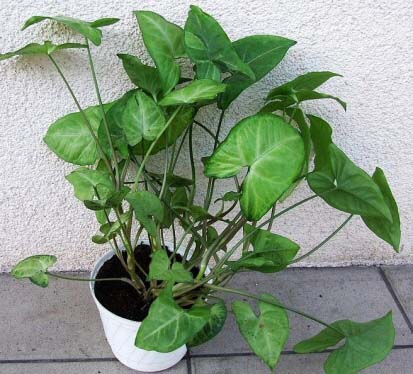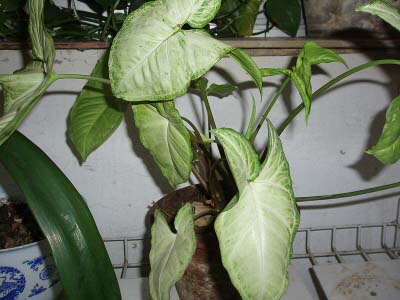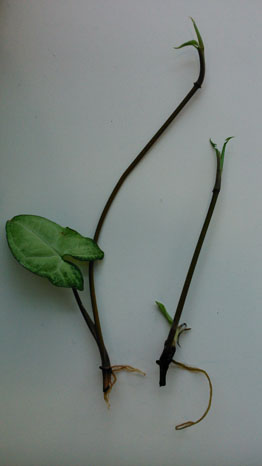





Syngonium podophyllum or the Goosefoot Plant is a simple but elegant and versatile houseplant. On our scale of Easy, Intermediate or Difficult, we ranked it Intermediate.  It's actually "Easy" to look after in most homes, however because it has a unruly nature and tendency to creep quietly around your home (if allowed), it needs a certain amount of maintenance and pruning that other plants ordinarily don't. This is needed to keep Syngonium indoors looking great and to avoid the ugly flop effect, also because all parts of the plant are poisonous you really do want to know where all parts of the plant are growing and creeping around, especially if you have curious children or hungry pets around.
It's actually "Easy" to look after in most homes, however because it has a unruly nature and tendency to creep quietly around your home (if allowed), it needs a certain amount of maintenance and pruning that other plants ordinarily don't. This is needed to keep Syngonium indoors looking great and to avoid the ugly flop effect, also because all parts of the plant are poisonous you really do want to know where all parts of the plant are growing and creeping around, especially if you have curious children or hungry pets around.
So let's get down to business and lay down the plus points of this interesting plant. Firstly, it ranked in Dr Wolverton's top 50 houseplants to clean the air. Secondly it is rarely troubled by pests and doesn't object too much if you throw the occasional bit of neglect it's way. Thirdly, it has amazing foliage with a variety of different variegation on the leaves. The cultivars you can buy are quite diverse although "White Butterfly" (below) is considered one of the best looking and consequently is the most popular.  Keep a look out though for "Imperial White" and "Emerald Gem" both of which have a striking appearance.
Keep a look out though for "Imperial White" and "Emerald Gem" both of which have a striking appearance.
The fourth plus is its versatility in that Syngonium can be grown easily as a compact bushy looking plant, or you can accept its creeping, climbing nature and grow it tall up a moss stick. It also plays well if you want to grow several different types of house plants together in a large container (although for the fashion and style conscious, that type of arrangement is currently, er, not "in").
It's cheap to buy and easy to propagate is our fifth plus. Our sixth and final selling point is more of an interesting observation about the leaves. As a young plant expect arrow head shaped leaves, with strong, bold variegation. As it ages however the leaves completely change shape to give a lobed finish. So if you compared a recent cutting with it's parent you may even think they are different plants entirely.
Light
However Syngonium's are displayed, when it comes to light requirements they will do well in a position where they receive good light but no direct sunlight.
Watering
Just remember to water well and then wait. Simple.
The soil needs to be evenly moist when you water, waiting for the soil to dry a little before evenly watering again. This means you should avoid the "little and often" approach, just remember to water well and then wait. Simple. In Winter the "wait" period will increase as the plant will take longer to dry out so adjust accordingly.
Humidity
Humidity is some what important for Syngoniums because very dry air will encourage brown leaf crisping which on mass will distract from the beautiful leaves. All the usual ways of increasing humidity can be used to prevent this.
Feeding
It's good to try and feed an established plant a few times a month. Like most house plants Syngoniums do "rest" in Winter but for only a short period, so even in the middle of the coldest months outside (providing the indoor room is warm) it's usual to see new leaves emerging. Therefore it's fine to feed in Winter too if you want. But only if the plant is actually growing and therefore has need of the fertiliser. If in any doubt don't bother.
Temperature
This is one house plant which needs to be at the heart of your home because it demands warmth, even in cold months. An unheated conservatory in Winter for example is a no no. A minimum of 16°C / 61°F.
Repotting
As with a lot of climbers there is often considerably more green growth creeping around the place when compared to what is happening underground. For this reason they do pretty well in small pots, however if you are watering more frequently or growth has slowed (and you want more), repot into a bigger pot during Spring using any standard compost mix.
Propagation
Propagating a Syngonium is easy peasy. You can root cuttings in water, or straight into potting compost. Both methods have a good success rate - providing you cut the right part of the plant.  You want a new growth shoot that either has one or two leaves already, (or the formation of one). Follow the growth shoot downwards several inches until you reach a pair of "nodes", these are a set of two small bumps (one on each side of the stem). The cut needs to be made just a few centimeters below the nodes because this is where the new roots come from (see the picture on the right and if you look closely you can see the nodes sticking out where the roots are forming).
You want a new growth shoot that either has one or two leaves already, (or the formation of one). Follow the growth shoot downwards several inches until you reach a pair of "nodes", these are a set of two small bumps (one on each side of the stem). The cut needs to be made just a few centimeters below the nodes because this is where the new roots come from (see the picture on the right and if you look closely you can see the nodes sticking out where the roots are forming).
If you are rooting using water, it's just a case of dropping the cutting in and keeping the water topped up. A few weeks later you will hopefully start to see new roots. Wait until you have a network of roots before carefully potting up in a free draining compost mix. If you have opted to plant the cuttings straight into compost, then it's a good idea to dip the cut ends into a rooting hormone first.
Speed of Growth
A Syngonium will grow steadily for much of the year providing it has good conditions. Left unchecked a stray vine can creep several feet in only a few months.
Height / Spread
As with many creepers and climbers you have to exercise a level of control and authority by pinching out stray growing vines, otherwise you end up with a unruly plant. A well trained mature Syngonium growing up a moss stick will, as a guide, give you the following dimensions: 1.8m / 6ft in height and a maximum spread of 60cm / 2ft. Plants grown with no height support wont grow very tall at all, although you can still expect a bushy looking plant.
Flowers
There are flowers which appear on mature Syngoniums, although they aren't very exciting or interesting. The key selling point of this particular house plant is the foliage.
Anything Else?
If the juvenile foliage along with a more compact plant is preferred, cut off all the climbing stems that develop — this will keep it bushy and neat. The leaves will be arrow-shaped rather than the adult lobed style.
Copyright © www.100flowers.win Botanic Garden All Rights Reserved